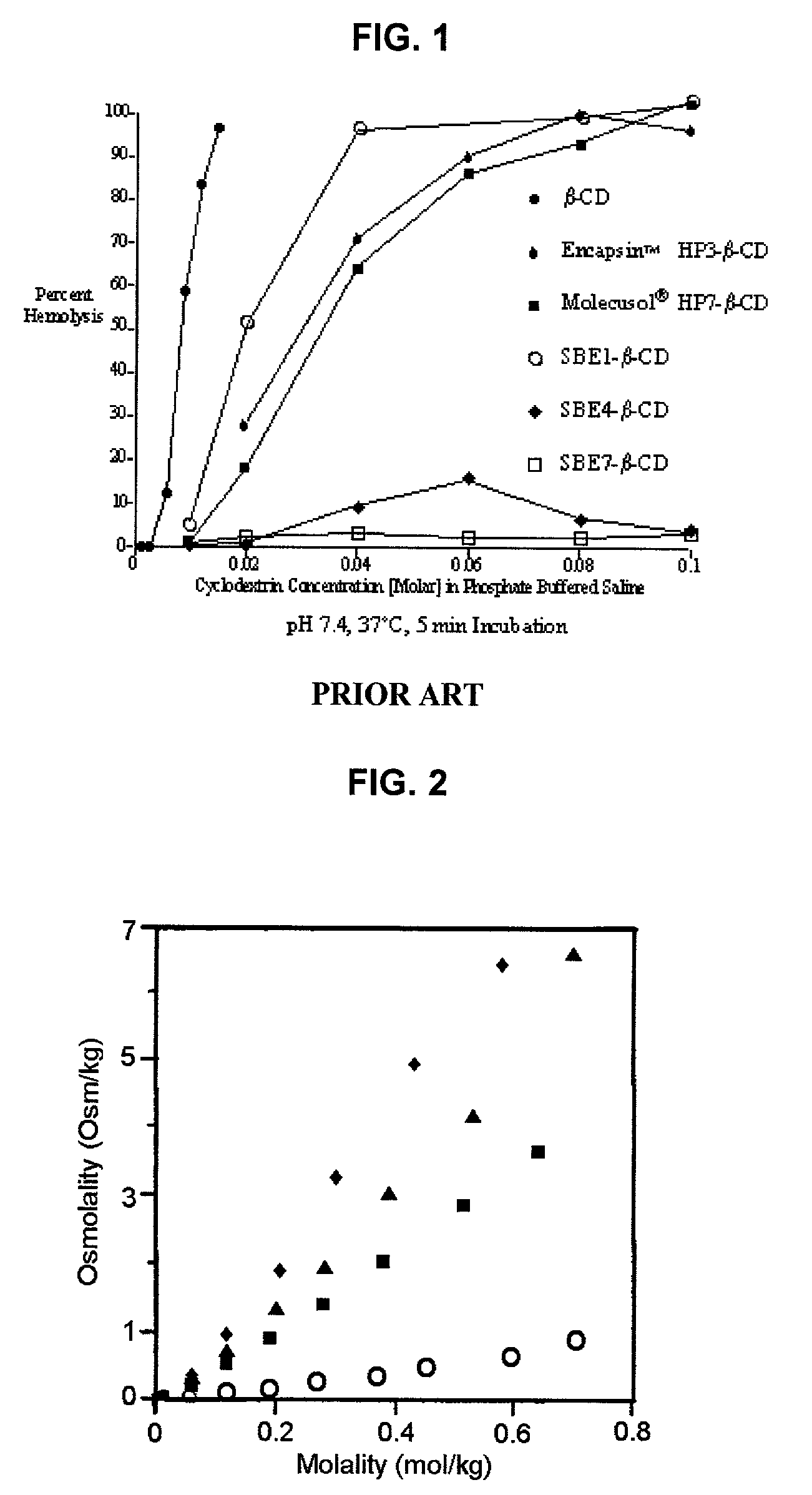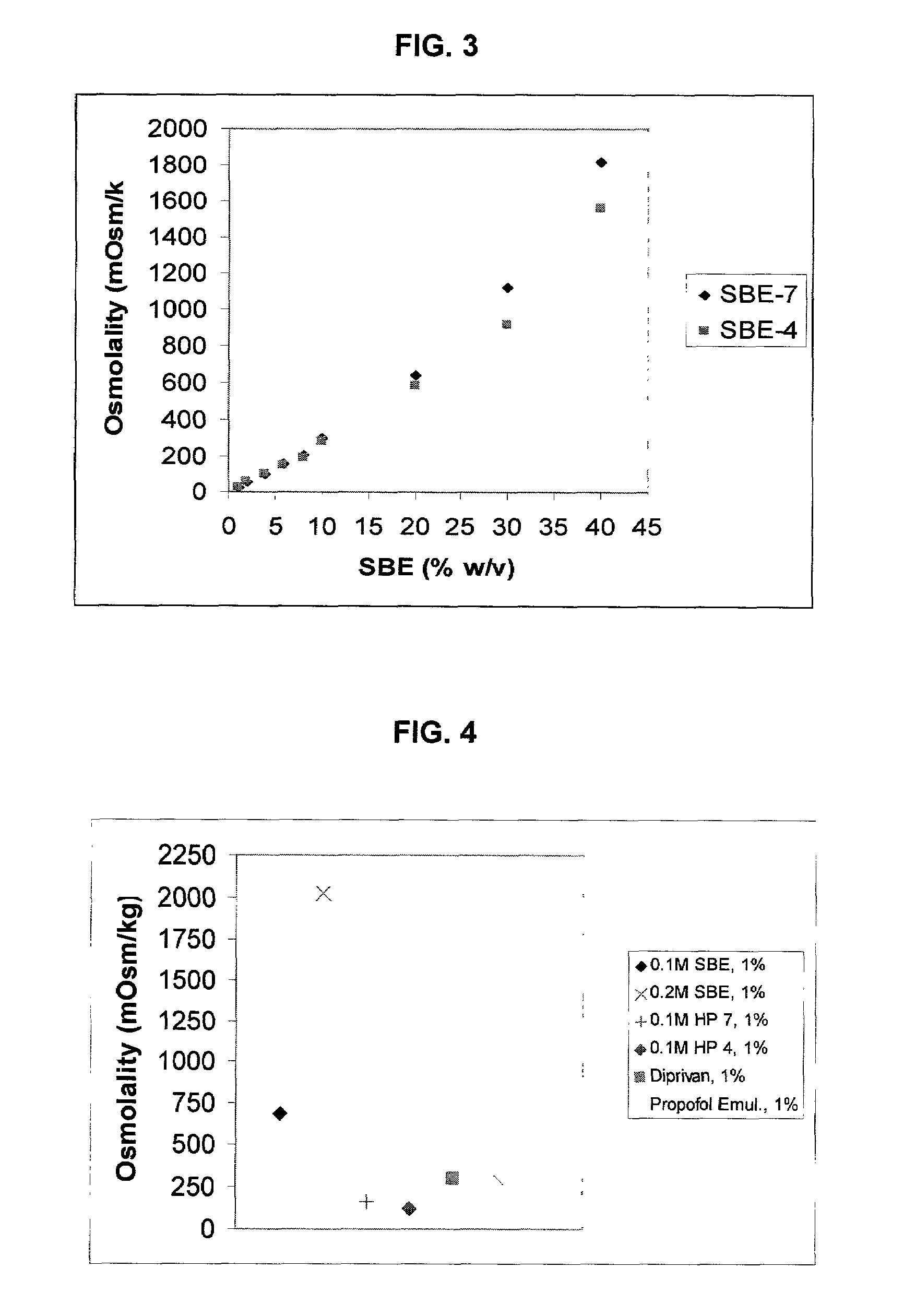Formulations containing propofol and a sulfoalkyl ether cyclodextrin
a technology of cyclodextrin and alkyl ether, which is applied in the field of anesthesia liquid formulations, can solve the problems of high pain incidence of propofol, emulsion formulations are typically problematic, and the pain of propofol is associated with significant pain, so as to reduce the risk of bacterial contamination, reduce the risk of infection, and reduce the effect of pain on injection
- Summary
- Abstract
- Description
- Claims
- Application Information
AI Technical Summary
Benefits of technology
Problems solved by technology
Method used
Image
Examples
example 1
[0145]An exemplary formulation according to the invention was made according to the following general procedure. CAPTISOL® cyclodextrin was dissolved in water to form a solution containing about 220 mg / mL of CAPTISOL® cyclodextrin. Propofol was added to the SAE-CD containing solution until a concentration of about 10 mg / niL propofol was reached. A formulation currently being evaluated in animal and clinical pain-on-injection studies and comprising the following components in the amounts indicated was prepared as indicated above.
[0146]
IngredientAmountValuePropofol 10 mg / mL0.056 Molar (mw = 178.28)CAPTISOL ® cyclodextrin220 mg / mL0.102 Molar (mw = 2163)Sterile Water for Injectionto volume
[0147]The pH of the solution was not adjusted and no antioxidants or preservatives were included.
example 2
[0148]The procedure of Example 1 was followed to prepare a general liquid formulation comprising propofol and an SAE-CD, which included the following ingredients in the approximate amounts indicated.
[0149]
IngredientAmountPropofol10 mg / mL ± about 10% wt.CAPTISOL ®Sufficient to form a CAPTISOL ® cyclodextrin / propofolcyclodextrinmolar ratio of about 1.1:1 to 2:1 and to yield aCAPTISOL ® cyclodextrin concentration ofabout 145–270 mg / mL, wherein CAPTISOL ®cyclodextrin has a molecular weight of about 2163.(It is noted that the exact weight of CAPTISOL ®cyclodextrin used will vary depending upon thespecific molecular weight of the batch ofCAPTISOL ® cyclodextrin being used.)Waterq.s.
example 3
[0150]
IngredientAmountValuePropofol 10 mg / mL0.056 Molar (mw = 178.28)CAPTISOL ® cyclodextrin216 mg / mL0.100 Molar (mw = 2163)EDTA 0.1 mg / mL0.01% w / vWaterto volume
[0151]CAPTISOL® cyclodextrin was dissolved in water to form a solution containing about 0.1 Molar (approximately 216 mg / mL) of CAPTISOL® cyclodextrin. Disodium ethylenediaminetetraacetate was added to the CAPTISOL® cyclodextrin solution at 0.01% w / v and dissolved. Propofol was then added to the SAE-CD containing solution with stirring until a concentration of about 10 mg / mL propofol was reached. The pH was then adjusted to 7–8.5 with sodium hydroxide. The solution was purged with nitrogen gas then filtered through a 0.22 micron pore size filter into a sterilized glass vial. The headspace of the vial was purged with sterile filtered nitrogen gas and the vial was sealed.
PUM
| Property | Measurement | Unit |
|---|---|---|
| pore size | aaaaa | aaaaa |
| pH | aaaaa | aaaaa |
| pore size | aaaaa | aaaaa |
Abstract
Description
Claims
Application Information
 Login to View More
Login to View More - R&D
- Intellectual Property
- Life Sciences
- Materials
- Tech Scout
- Unparalleled Data Quality
- Higher Quality Content
- 60% Fewer Hallucinations
Browse by: Latest US Patents, China's latest patents, Technical Efficacy Thesaurus, Application Domain, Technology Topic, Popular Technical Reports.
© 2025 PatSnap. All rights reserved.Legal|Privacy policy|Modern Slavery Act Transparency Statement|Sitemap|About US| Contact US: help@patsnap.com



